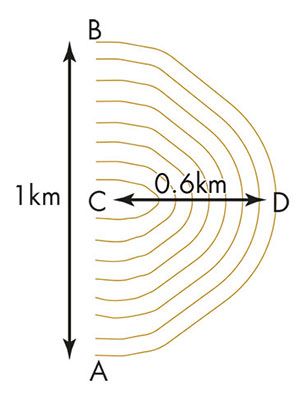March 2020 - Contours, round or over, how to do a rough calculation
by Nigel Williams

Next, we count up the contours we cross going up. 8 = 120m of ascent on a Harvey map (15m contour interval). If we assume a walking speed of 4km per hour, 1.6km around the end of the ridge will take approximately 24 mins.
If we assume, according to Naismith's Rule, that we add 1 minute per 10m of ascent we get 12 minutes to add to the 15 minutes direct route over the ridge, giving a total of 27 minutes. So, in this example we might be quicker going around.
Of course, we all travel and manage hills at different speeds. Steepness and under foot conditions have a varying impact. If this example used a 10m interval for the 8 contours then it might be margin-ally quicker to go over.
On a mountain marathon the cunning route planner starting from A would have a check point at B, and then have the next check point back up on the ridge but several kilometres further along. So those that don't plan beyond the next check point risk climbing the hill twice instead of going around and then enduring the climb just once.
Return to the Navigation Blog
 FREE UK delivery
FREE UK delivery For Christmas delivery information
For Christmas delivery information 







